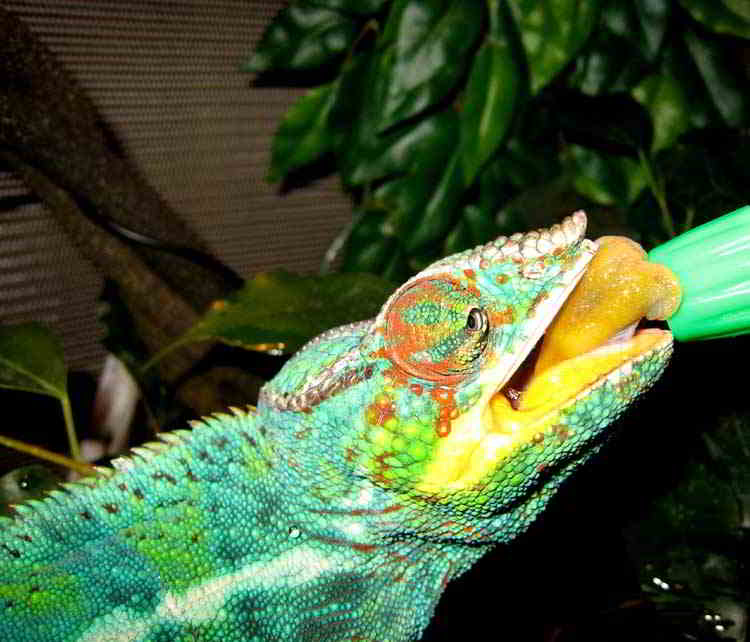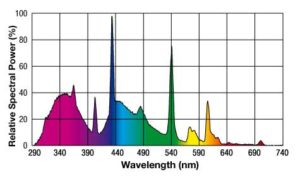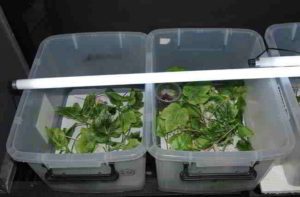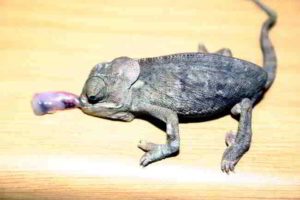Water for chameleons – essential for health
In the wild, normally chameleons drink from water drops on leaves after rainfall or from heavy dew. Chameleons can absorb water through their skin but they still need to drink. Due to the high humidity in certain rain forest habitats, the regular heavy morning mist there provides extra hydration for montane chameleon species.
In captivity, an owner should try to replicate these situations to ensure the best chameleon care. This requires some research in where your chameleon comes from. A Panther chameleon and a Veiled chameleon, for example, come from very different habitats. (Books about chameleons can give valuable background about various species origins – checkout our book selection.)
Sadly, this research doesn’t always happen leading to the two most common problems found in captive chameleons – dehydration and metabolic bone disease.
The two most common mistakes in providing water to a chameleon are either not doing so in the right manner, or giving too little through insufficient spraying.
It’s not necessary to provide a constant water supply for chameleons, so long as it is regular (that is several times a day), done in a way that the chameleon can drink the water and sufficient quantity that the chameleon gets enough each day. The important thing is keeping the chameleon hydrated.
It is very rare for chameleons to drink from a bowl. There will always be someone who claims to have a chameleon which does but, even if true, it’s very unusual. Your chameleon is likely to become fatally dehydrated if you expect it to do the same.
Providing water the correct way is straightforward and easy to do. Here are some suggestions:
Providing water for Chameleons the correct way
There are several ways to successfully provide water for chameleons. In each case, the water needs to run off the leaves or branches so that the movement catches the reptile’s eyes and it starts drinking. Normally, the water will need to run for a few minutes before the chameleon shows interest, and it needs to continue until the animal stops drinking.
If you wonder how much water chameleons drink a day, you need to know that a daily, cursory spray is insufficient. Sadly, I’ve seen people spray their chameleons as quickly as they would a houseplant, stopping as soon as the leaves are wet. That’s never enough.
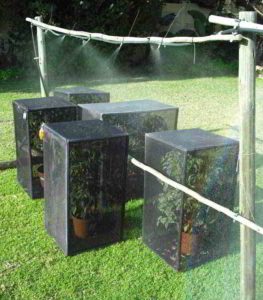
Spraying must be a sustained event, as it would be during a downpour of rain. The water should be running freely down the leaves and branches for several minutes. And the process should be repeated during the day, not just done once. Twice is good, three times is better. This is a good reason why adequate drainage in the cage is essential.
Hand spraying
This is a good method but requires daily attention and time. The spraying should be done at least twice a day, which for many people is not practical. Unless you have strong hands, I’d suggest you invest in a 5-litre pump spray, especially if you own more than one cage.
Waterfalls
Pet shops love to sell artificial waterfalls as they look quite attractive as part of the overall set-up. However, I recommend avoiding them.
They have gained a well-deserved reputation for potential hygiene problems. This makes sense, as any body of water kept warm and aerated becomes an ideal breeding ground for bacteria. And that’s what happens when water is continuously pumped around an artificial waterfall. If the chameleon defecates into the water or a cricket carelessly drowns in it, the chances of the water becoming polluted are high.
Drip Systems / Ice cubes
In emergencies, I’ve used a 5-litre plastic box as a water reservoir, placed on top of the cage. Water drips into the cage through a small hole drilled in the bottom of the box. For better control, I run a short pipe from the bottom of the box so it ends above some leaves. By connecting a small plastic tap to the pipe, I can control the amount of water dripping. The kind of tap used in aquariums to control air pumps is ideal.
I have found two potential problems with this setup, neither of which is insurmountable. The first was that the drip system delivered five litres of water inside the chameleon cage each day which required good drainage.
The second problem was that the hole often got blocked. If this went unnoticed, the chameleons had no water but as I was working at home, I could fix this before it became a problem.
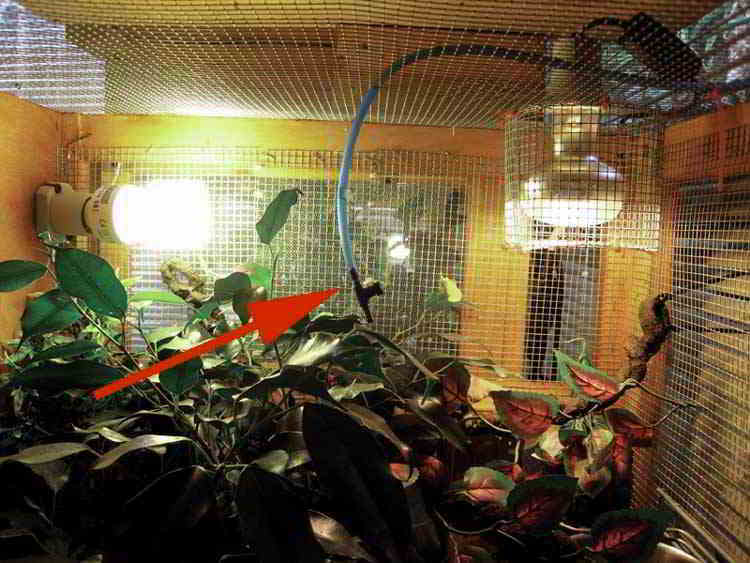
Some books suggest an alternative by placing ice cubes in a plastic container with a small hole in the bottom. As the ice cubes melt, the water trickles through the hole and dribbles down the branches. This idea, however, has several flaws. The first is that the water may be too cold when the chameleon drinks it. The second is that, depending on where you live, the ice cubes are likely to melt too fast for the idea to be practical.
Automated Watering Systems
Automated watering is by far and away my favourite system. And why not? It supplies the correct amount of water, when and where it’s needed. And, aside from making sure the system continues to function properly, minimal work is involved!
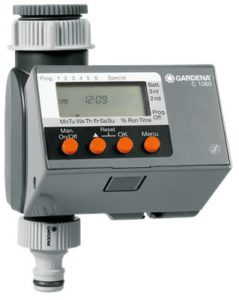
Several types of automated watering systems, of varying complexity, are available on the market. In both South Africa and Malaysia, I have relied heavily on automated garden irrigation systems, such as those sold by Gardena, which are set to spray at timed intervals. I set them to spray roughly three times a day for fifteen minutes, except in winter (South Africa) or the wet season (Malaysia) when they run only twice a day for ten minutes.
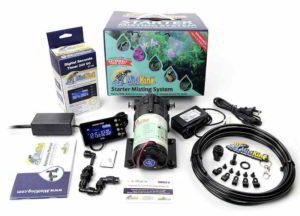
Other systems designed for reptiles include MistKing. These generate a mist or very fine spray, rather than the more rain-like effect from the gardening systems but they work well.
Dehydration
If a chameleon is not drinking properly, it will soon become dehydrated. Its eyes will take on a sunken appearance. You should also regularly check the colour of its faeces. The urate should be white. If it’s yellow or orange, it’s a possible sign of dehydration. Other factors can cause sunken eyes and discoloured urate but these are warning signs to look out for.
Unfortunately, even limited dehydration can occur without any obvious signs. The resulting damage to the chameleon’s internal organs may be irreversible if the situation isn’t fixed quickly. Providing adequate water for your chameleon is not something to leave to chance.
Emergency Care
If you think your chameleon is dehydrated, seek the advice of a vet who knows about chameleons immediately. You can’t afford to wait to see if it gets better.
If you’re just worried your reptile didn’t drink the day before due to a problem with the watering system, it’s probably not too serious. Some species come from regions where rainfall is not a daily occurrence. However, there is normally heavy dew even in the dry season.
Some keepers advocate putting the chameleon on a large branch and putting it in the shower. You obviously need to check and monitor the force and temperature of the water carefully. The experience may be too stressful for your chameleon. I’ve not tried this method.
What has worked for me is dripping water onto a leaf in front of the chameleon. You can also sometimes get them to take water from the nozzle of the spray bottle or the drips from the end of a large plastic syringe. You will probably need to spend a long time doing so, but it’s worth it if the chameleon drinks.
Summarising Water for Chameleons
Providing water for chameleons correctly is one of the most easily overlooked essentials for a chameleon. That’s partly because there are no shortcuts (aside from automation). The chameleon needs daily access to adequate, clean dripping water.
I haven’t discussed whether tap water or bottled water is best. That is a personal decision, which may be affected by where you live and the quality of your tap water. Obviously, the water must be clean and any container used as a reservoir for sprays, etc., should be kept clean.
If you can automate the watering process, it’ll remove most of the risks and cut down the time involved. More important, the health of your pet will be safeguarded. And it will make looking after your chameleon fun rather than a chore.
